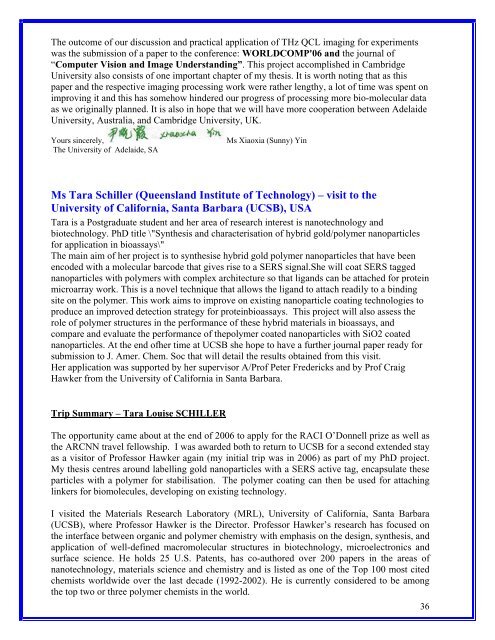Annual Report 2007 - The Australian Nanotechnology Network
Annual Report 2007 - The Australian Nanotechnology Network
Annual Report 2007 - The Australian Nanotechnology Network
You also want an ePaper? Increase the reach of your titles
YUMPU automatically turns print PDFs into web optimized ePapers that Google loves.
<strong>The</strong> outcome of our discussion and practical application of THz QCL imaging for experiments<br />
was the submission of a paper to the conference: WORLDCOMP'06 and the journal of<br />
“Computer Vision and Image Understanding”. This project accomplished in Cambridge<br />
University also consists of one important chapter of my thesis. It is worth noting that as this<br />
paper and the respective imaging processing work were rather lengthy, a lot of time was spent on<br />
improving it and this has somehow hindered our progress of processing more bio-molecular data<br />
as we originally planned. It is also in hope that we will have more cooperation between Adelaide<br />
University, Australia, and Cambridge University, UK.<br />
Yours sincerely, Ms Xiaoxia (Sunny) Yin<br />
<strong>The</strong> University of Adelaide, SA<br />
Ms Tara Schiller (Queensland Institute of Technology) – visit to the<br />
University of California, Santa Barbara (UCSB), USA<br />
Tara is a Postgraduate student and her area of research interest is nanotechnology and<br />
biotechnology. PhD title \"Synthesis and characterisation of hybrid gold/polymer nanoparticles<br />
for application in bioassays\"<br />
<strong>The</strong> main aim of her project is to synthesise hybrid gold polymer nanoparticles that have been<br />
encoded with a molecular barcode that gives rise to a SERS signal.She will coat SERS tagged<br />
nanoparticles with polymers with complex architecture so that ligands can be attached for protein<br />
microarray work. This is a novel technique that allows the ligand to attach readily to a binding<br />
site on the polymer. This work aims to improve on existing nanoparticle coating technologies to<br />
produce an improved detection strategy for proteinbioassays. This project will also assess the<br />
role of polymer structures in the performance of these hybrid materials in bioassays, and<br />
compare and evaluate the performance of thepolymer coated nanoparticles with SiO2 coated<br />
nanoparticles. At the end ofher time at UCSB she hope to have a further journal paper ready for<br />
submission to J. Amer. Chem. Soc that will detail the results obtained from this visit.<br />
Her application was supported by her supervisor A/Prof Peter Fredericks and by Prof Craig<br />
Hawker from the University of California in Santa Barbara.<br />
Trip Summary – Tara Louise SCHILLER<br />
<strong>The</strong> opportunity came about at the end of 2006 to apply for the RACI O’Donnell prize as well as<br />
the ARCNN travel fellowship. I was awarded both to return to UCSB for a second extended stay<br />
as a visitor of Professor Hawker again (my initial trip was in 2006) as part of my PhD project.<br />
My thesis centres around labelling gold nanoparticles with a SERS active tag, encapsulate these<br />
particles with a polymer for stabilisation. <strong>The</strong> polymer coating can then be used for attaching<br />
linkers for biomolecules, developing on existing technology.<br />
I visited the Materials Research Laboratory (MRL), University of California, Santa Barbara<br />
(UCSB), where Professor Hawker is the Director. Professor Hawker’s research has focused on<br />
the interface between organic and polymer chemistry with emphasis on the design, synthesis, and<br />
application of well-defined macromolecular structures in biotechnology, microelectronics and<br />
surface science. He holds 25 U.S. Patents, has co-authored over 200 papers in the areas of<br />
nanotechnology, materials science and chemistry and is listed as one of the Top 100 most cited<br />
chemists worldwide over the last decade (1992-2002). He is currently considered to be among<br />
the top two or three polymer chemists in the world.<br />
36



